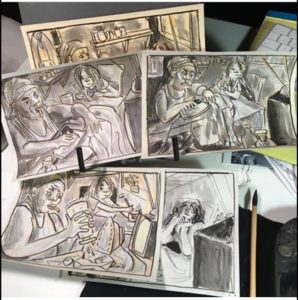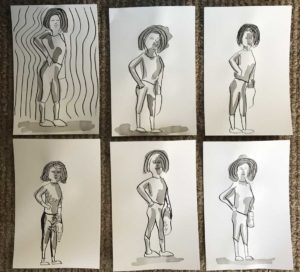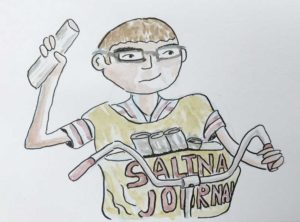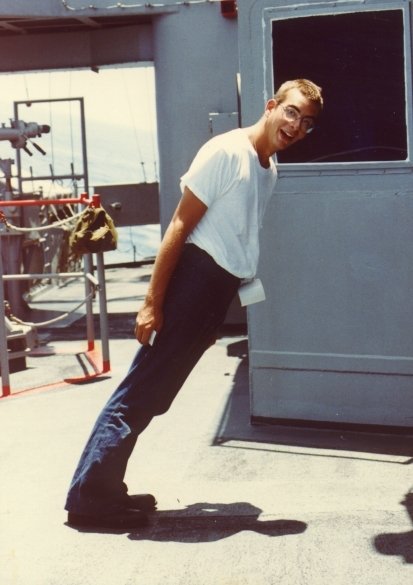I found Mary Doodles today! Wow, I wish I had seen this video before I started messing with dip pen and inks and ink washes with brushes. She’s great! Oh well. Better late than never! Here is Mary Doodles…
Category Archives: Uncategorized
Lynda Barry on Silencing the Inner Critic
Barry on Three Color Drawing
My oh my, Lynda Barry has been sharing a flurry of work lately. In this post, she talks about drawing the same picture three times in yellow, then orange, then blue. I have never heard of this technique before. She learned it from another cartoonist. I’m going to have to learn more about Art Spiegelman now.
Merging Canvas Course Sections
Thanks to Lisa Shappee, our resident Canvas expert, I now know how to merge two course sections into one course. It is not an easily discoverable process, but the directions are recorded in this K-State how-to post.
Value of a Series
I have been learning so much from cartoonist and accidental professor Lynda Barry. Her recent books have been profoundly informative about her creative process. I went to her Wisconsin workshop last November. As I anxiously awaited for that big day to arrive, I acquired several more of her books as companions to Syllabus, the book that introduced me to her work. The one that spoke deeply to me was 100 Demons, in which she discussed various formative events in her life along with a quick primer at the end on the art of using a Chinese paint brush with an ink stone and grinding ink. One of these brushes appears in the picture shown above.
I absolutely love it when Lynda shares her process and her working environment with us, and she does this frequently on social media. For me, it gives me hope. Not hope that I can be just like her if I only master her processes and techniques because there is only one Lynda Barry. But hope that I can be a better version of myself. Hope that there is something inside of me waiting to get out if I will only get busy working.
The thing that I notice in my students and if I’m honest, in myself as well is the tendency to want to short-circuit things. We want a simple fix. We want instant expertise, but it doesn’t work this way. In recent days, Lynda has been sharing one simple truth with us.
Insight takes time to acquire. Don’t try to rush it.
The thing that I always want to pass along to students, and keep in the forefront of my own mind is that nothing worth achieving comes easily or on the first try. So often we bang something out in response to an assignment or an idea and call it good. We think we are done after one iteration! True greatness doesn’t work that way.
Look at how many different times Lynda Barry has drawn the exact same scene. She is trying to gain understanding by staying in motion. She writes:
Something starts to happen when I draw the same scene a dozen times from memory. The drawings don’t get better or worse as I go. Instead the scene seems to come in and out of focus. I have to really push past wanting to stop. (Emphasis mine) when I can’t tell where it’s going to get to this other thing I can’t see while it’s happening.
I decided to experiment with this process, making several versions of the same image as well.
Her comment this morning about having to push past wanting to stop is what anyone who is at the pinnacle of their game has to do every single day. You don’t win the state championship, the gold medal or anything of importance by quitting after the first rep. You have to keep going.
I thought I was doing something special when I made six! I quit when I was only halfway finished. Also, one thing I have noticed about some of these recent drawings as compared to the drawings I was making at Lynda’s workshop when I look back at them is that I was drawing backgrounds with most every image and now I seem to have nothing to say about the background scenery.
Just look at the exquisite detail in the pictures L.B. has posted above. Obviously she has been doing this a long time, and probably can make detailed images like these much faster than regular people, but even so, a dozen images like what she’s showing us took her some time to make. I suspect it would take me an hour to make one picture that even approaches what she’s showing here. Next time, I will block out more time and try to make 12 iterations, remembering to include background details.
Thank you Lynda Barry, for showing us what greatness looks like.
Interest Inventory
Paper Boy
I was a paper boy in the 1970s. I wish I had a movie, or even a photograph of me doing that job. No one thought to take a picture of me. I did it for about three years. Wednesdays and Sundays were the hardest because the papers I delivered those days were full of advertising. I carried both the Salina Journal and when we moved to Nebraska, I switched to carrying the Omaha World-Herald.
These days, I do a skit in my class playing the role of a paper boy, comparing him to the IP layer of computer networks – that is, not completely reliable.
Here is a drawing I made of myself as a paperboy.
Heavy Seas
Mastering Academic Conversations – 2019 edition
In the fall semester of 2019, I taught for the second time a course called Mastering Academic Conversations. This is a class taught for all of our incoming freshmen students and it has a humanities general education component to it. We had around 100 students and I believe six faculty members teaching several different sections of the same course. On Wednesdays we had a plenary session where the different class sections would come together for a large lecture or other joint learning experience.
I taught a survey of humanities course several years ago but had to give it up when we introduced the new digital media degree and I was the only faculty member available to teach those courses. I really enjoyed teaching the humanities course so I was very interested in taking on the M.A.C. course with a similar theme. As it turns out, several of my faculty colleagues are not as excited about the humanities element in this course as I am, because they feel they are not qualified, do not have the interest and expertise, and so forth. As I mentioned, this was my second time through the course, and this past iteration, we had three new instructors for which this was their first time teaching it.
If a teacher is assigned to do a task that they are not excited about or are actively opposed to, there isn’t much you can do to change their mind and the results you get will undoubtedly be mixed at best. However, this is my take on it – you don’t necessarily need to be an expert to teach a survey class in humanities.
How many opportunities to we have to be model learners for our students? How often do we as faculty members put ourselves in the position of learning something new? How often do we allow room for uncertainty? I think we should embrace these opportunities, and show our students how to learn in new domains. I think we should demonstrate approaches to learning that find connections between what we know well and the new things we are trying to learn.
This M.A.C. class, above all things, is about helping new college students be successful in college. So we need to be teaching them good study skills, new learning skills, attitude and mental health skills, all of these things that we expect our students to have. Isn’t it interesting that we expect our students to hunker down, suck it up, or whatever it takes to get through a curriculum of courses that includes subjects they love and hate, but when it comes to our own lives, we naturally, as any human being does, gravitate towards the things we like and shy away from the things we dislike or know nothing about?
Scheduling Conflict
Fall of 2019 was a really unusual semester for me because of strangeness in scheduling, I was double-booked on courses. I had M.A.C. at the exact same time as a Visual Communications studio course I was scheduled to be team-teaching in another room. Needless to say, I was never in two places at once, and since the VisComm class was longer in length, I would make an appearance after my M.A.C class had ended. It was a studio, so this wasn’t really a problem, but it made me feel out of the loop, because a lot of the updates, assignments, discussions and so forth happen at the beginning of a class period, not later on. Occasionally, when we were critiquing a project or something, the group would wait for me to arrive after my other class, but even so I felt mostly like an outsider and would prefer to never have this double-scheduling again if possible.
M.A.C. Innovations
I did several things differently this go-around in the MAC class. For instance, on the very first day of class, before we made introductions, I kicked the class off by playing ukulele and having a sing-along. Believe it or not, new freshmen will sing along with you on the first day if you act like it is expected and you are enthusiastic about it. I was amazed! I was singing the cowboy song Abilene which is so repetitive, it is easy to sing along on the chorus, so about the third time through I (half-jokingly) said “Everybody!” and they started singing Abilene, Abilene, prettiest town that I’ve ever seen…” I highly recommend starting a class like this with a song.
Also new this semester, we did a “Speed Friending” activity that I’ve been thinking about doing for community-building and getting to know each other. This is simply a new spin on the old “Speed Dating” idea in which you form two groups of people, where one group sits on one side of a table, and the other group moves from one person to the next over a set period of time. I’ll have to check the details of what we did for certain, but I think we allowed 2-3 minutes for a conversation, so each party could ask questions of their partner from a “cheat sheet” of pre-prepared questions, or ask one of their own. That way in the course of an hour, they would meet a large number of others taking the same course. We gave them time to exchange contact information to make “study buddies” and then we asked them to submit a list of names and how they would stay in contact with their new friends. This activity was well-received and a great way to begin a semester in a large class as well.
Each week, our class has themes, typically as suggested by the teaching faculty based on their interests and expertise, and during our large-lecture day on Wednesday, the lead faculty on that topic leads an activity or lecture on that theme. I led two weeks this past semester, one on Digital and Media Literacy, which was similar to what I did the previous year and another on Art History.
For media literacy, I had a campfire video, and arranged the chairs in the room in a semi-circle around the “fire.” I told stories of how human communication has evolved over the millennia, starting with tales around a fire; fire being one of the first memes or ideas to go viral. We discussed memes and how they get and hold our attention. I showed how most of the technologies that we currently use have been introduced in the very recent history of human communication. Books have been around for centuries, writing much longer than that, images were the first written communication, but our digital tech is something old and something new. We are returning to the visual, the auditory, the storytelling roots of the campfire, but at the same time we are turning inward, we are using media to put distance between ourselves and others and we wonder why we are sad.
I gave a media literacy assignment that encouraged using Social Media for the serious purpose of following experts in their chosen field to begin building a personal learning network.
The other theme I led was in Art History. This was something new. Again, there was a conflict on my week to do the Art History lecture because I had to go out of town on a recruiting trip. So I spend several hours making and recording a video lecture called You Should Know This Image.
How To Get a Book ISBN
I always wondered how to get an ISBN for a self-published book. Now I know. https://www.myidentifiers.com/identify-protect-your-book/isbn/buy-isbn
Also, here is a link to self-publishing on Amazon: https://kdp.amazon.com/en_US/l/print-on-demand
I found these on this here blog: https://notjohnkdp.blogspot.com/



